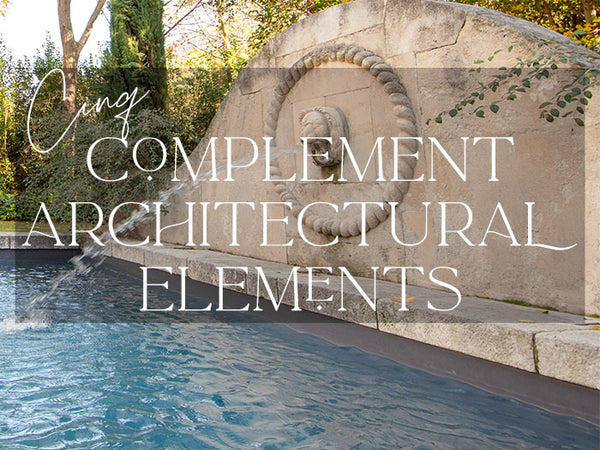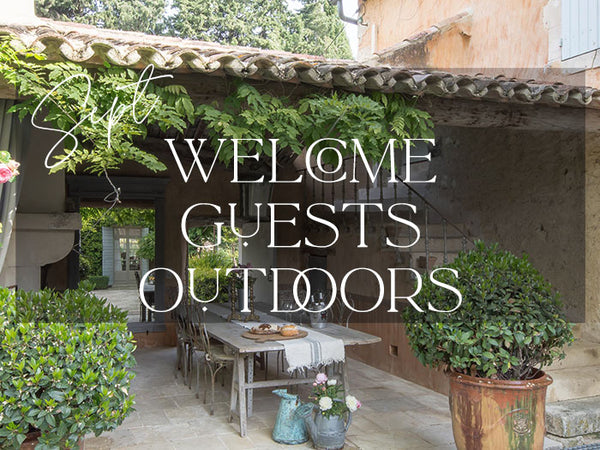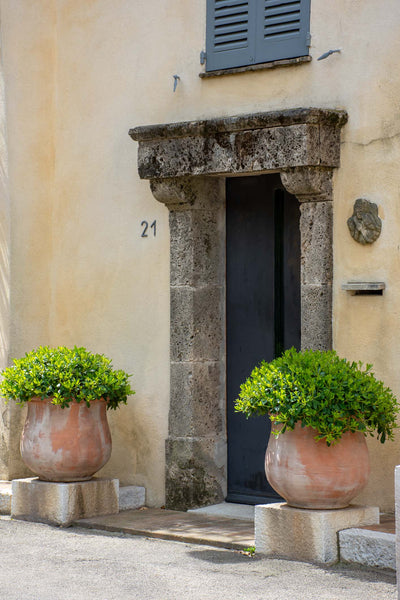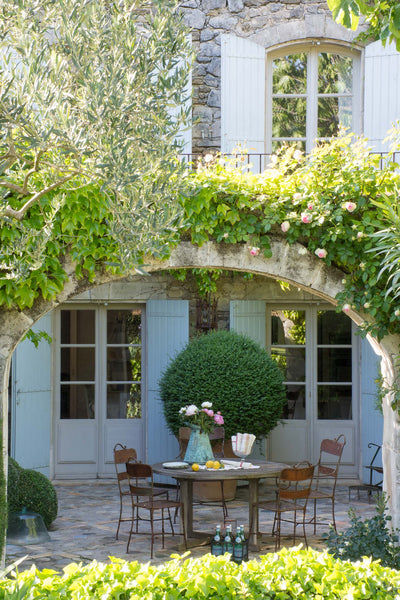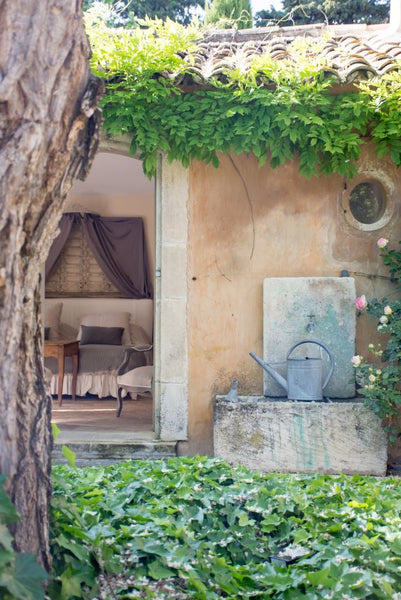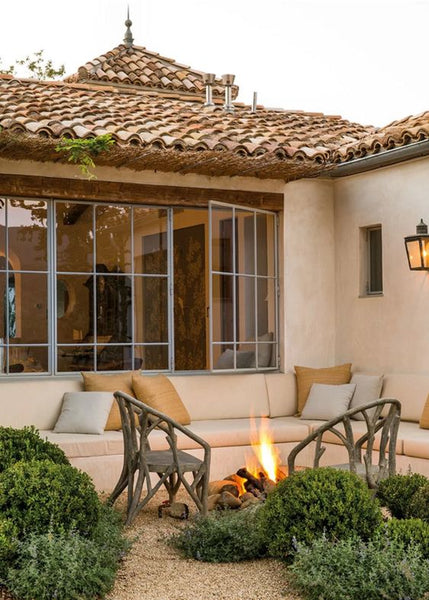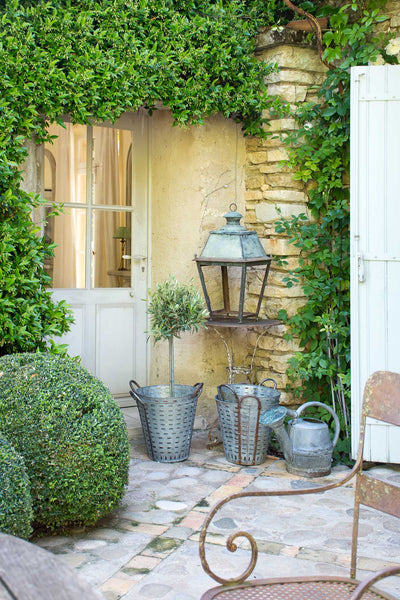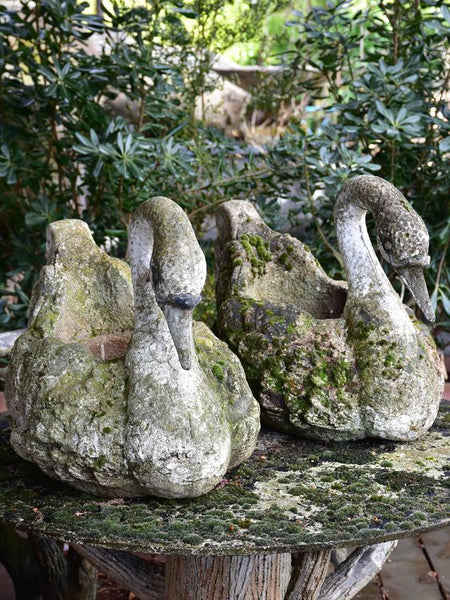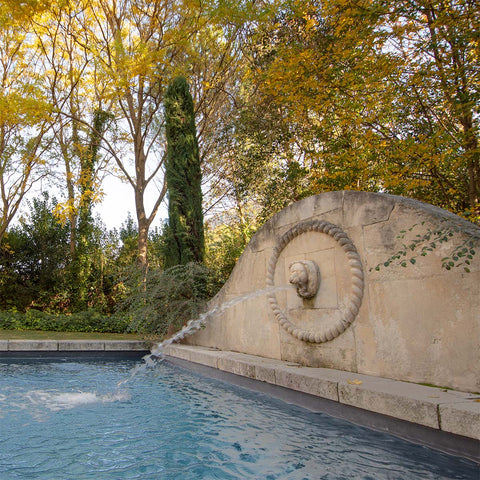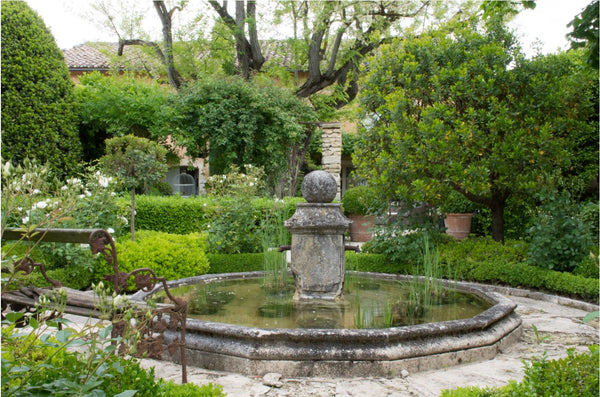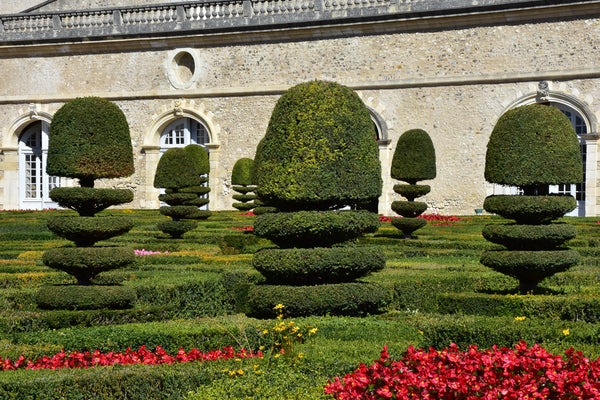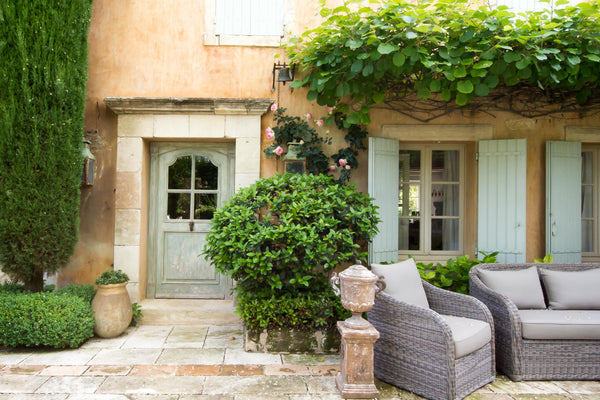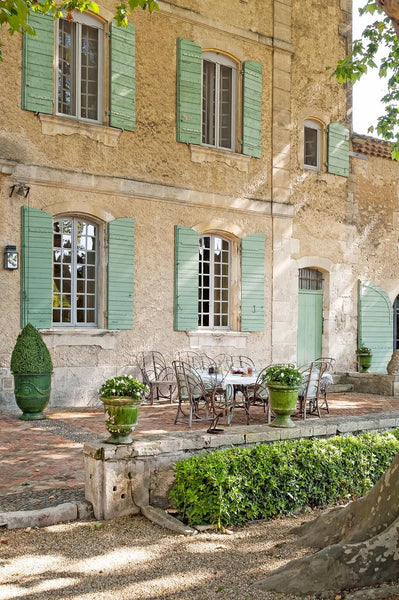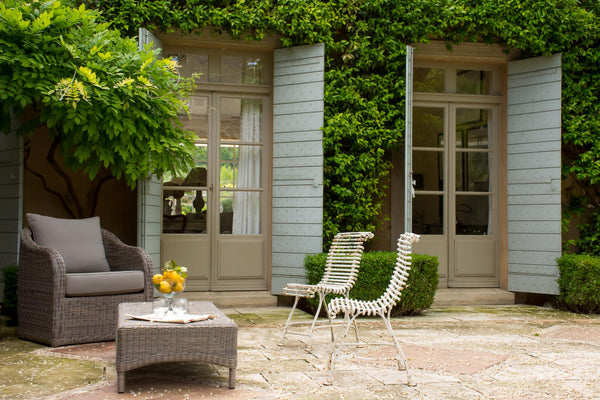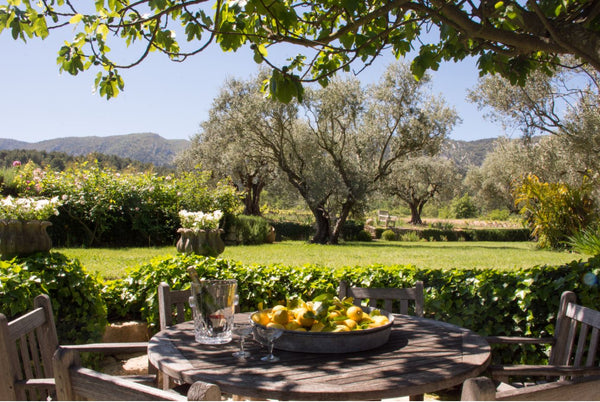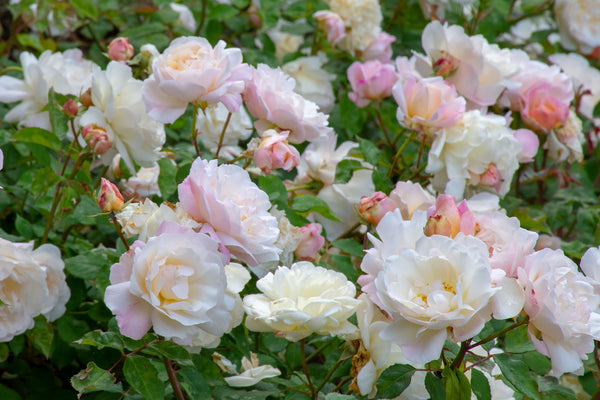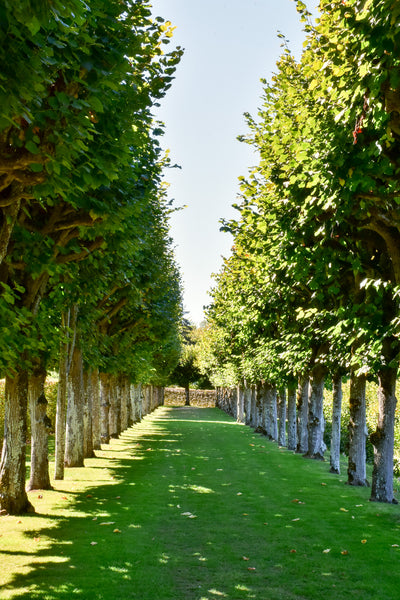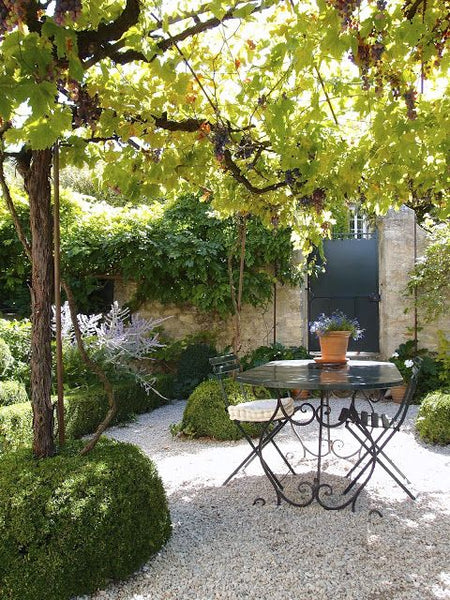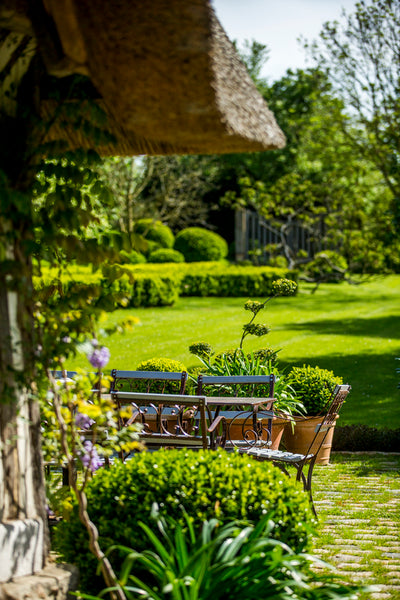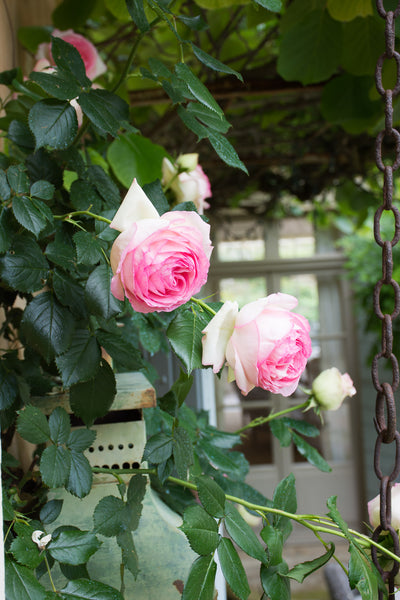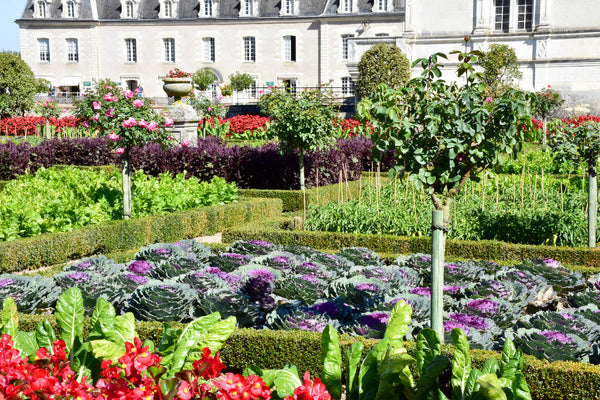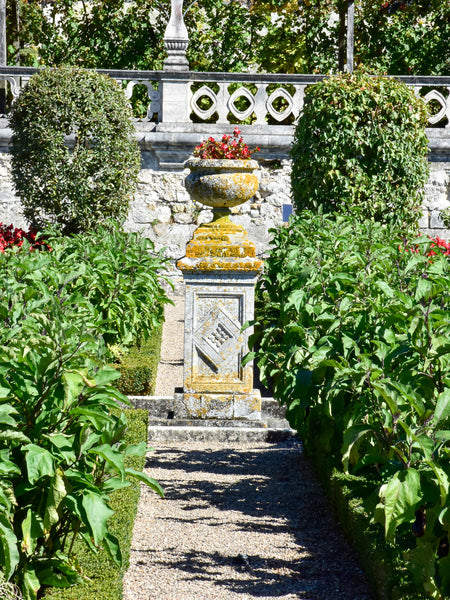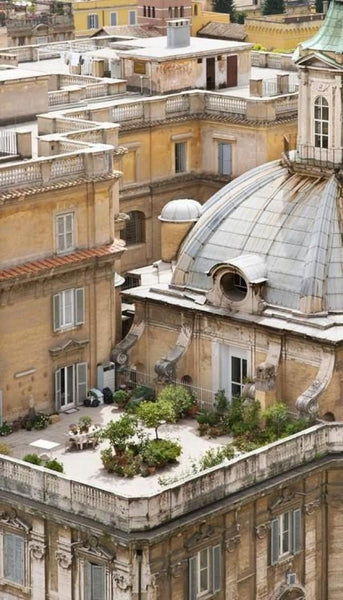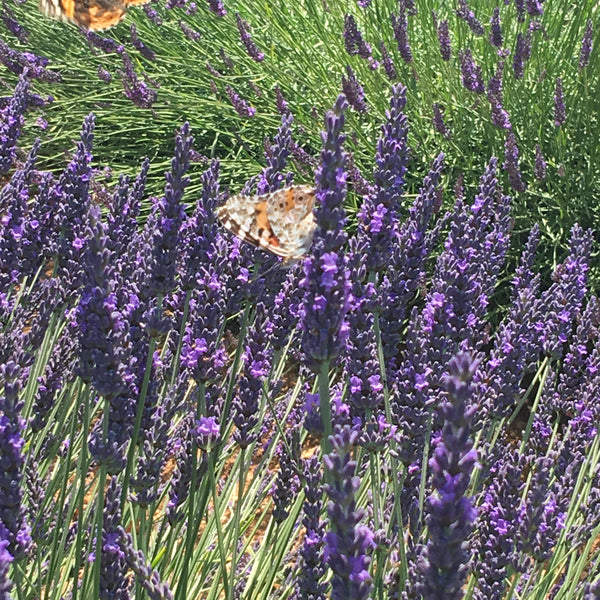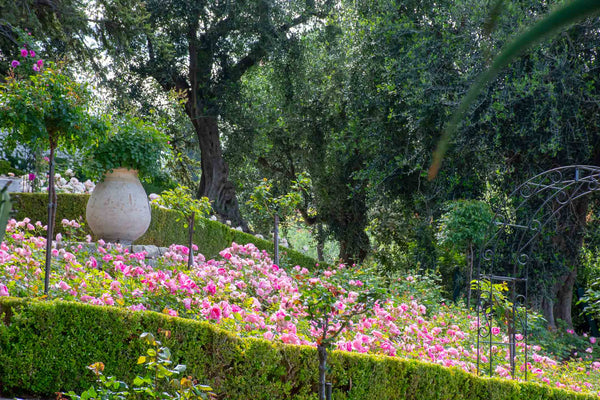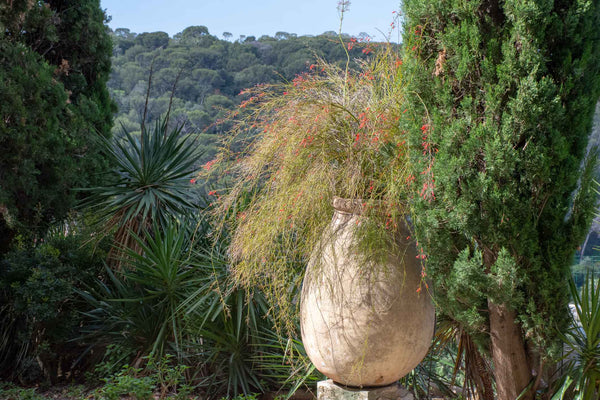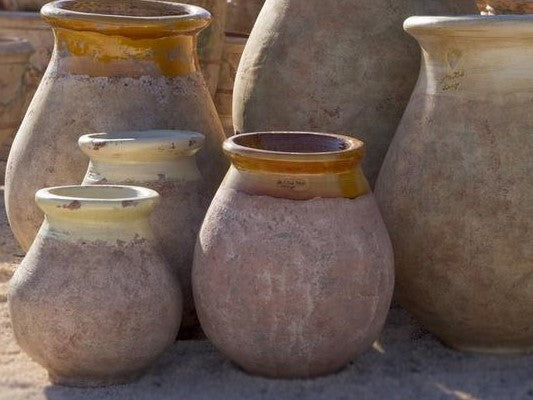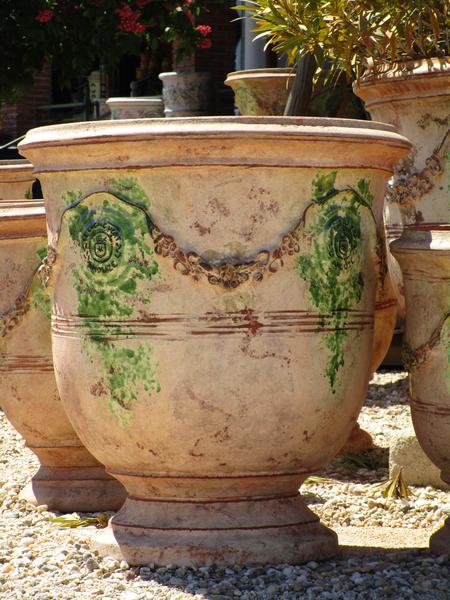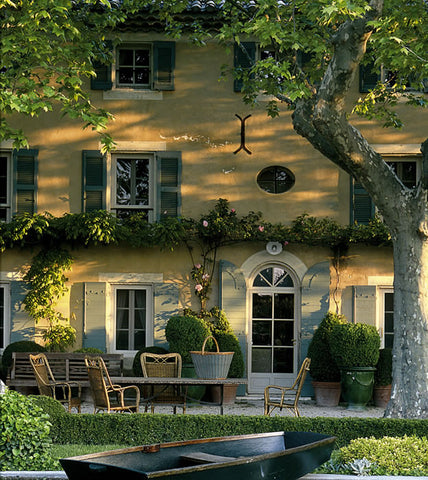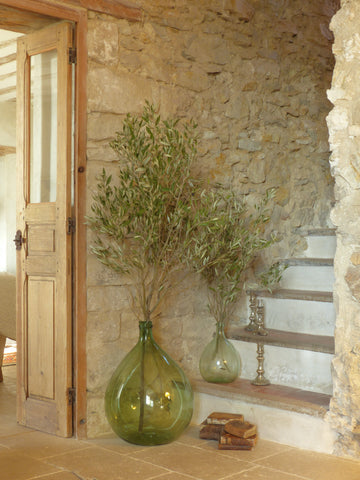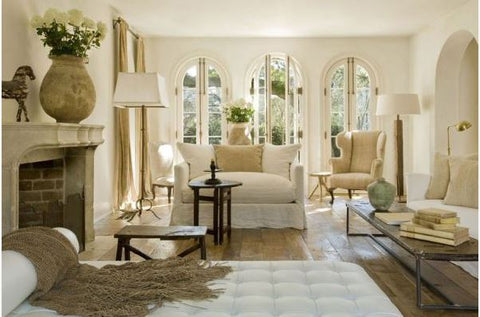8 ways to create your French garden
Explore the exquisite charm of these eight garden design ideas, each capable of transforming your outdoor space into a quintessentially French haven. Implementing tip number three is guaranteed to infuse an instant touch of French elegance into your garden!
Click on the images below to be inspired by the most idyllic French gardens. Uncover the mysteries behind classic French landscape design, whether it's for majestic estates, romantic Parisian-style balconies, or charming country gardens.
1. Display traditional planters

Regardless of their size, French gardens typically showcase exquisite garden planters in both formal classical and modern styles. Pots and planters come in a wide range of sizes, colors, and materials, offering a delightful array of options to explore. Classic and timeless, cast iron Medici urns add a touch of elegance, while antique planters boast incredible patinas and embody the unique characteristics of the regions in which they were crafted.
Meticulously crafted by hand since the eighteenth century, Anduze urns are made from terracotta and adorned with sculptural garlands, finished with green and yellow glazes. Traditionally, these urns were used to plant citrus trees. Prior to planting lemon, lime, orange, or kumquat trees, it's essential to assess their suitability for your climate or be ready to provide shelter, such as a glasshouse, during the winter months.
You can combine and blend antique Anduze urns, or select your size, design, finish and quantity from our exquisite range of artisan made Anduze urns.
Enhance architectural elements like a doorway or garden gate by planting antique and vintage pots with evergreens. Unglazed garden planters possess a unique charm as they thrive when exposed to the elements, gradually weathering and developing their distinctive patina over time.
Gardener's tip: Stimulate moss growth by blending some moss with milk or beer and painting it onto the terracotta planter. Then pour over some additional milk to the planter's surface. Ensuring the moss stays moist is crucial, adjusting a water sprinkler to regularly reach the pots will keep it nice and green.
2. Choose iron and marble furniture
The allure of French garden furniture lies in its superior craftsmanship, timeless design, and enduring durability. Arras furniture from the north of France is made with wrought iron, and oh so romantic! Authentic Arras pieces are identified by their trademark feet of either hooves sabots or paw feet (which also indicate their age) and sometimes they are branded with a small badge.
Imagine the charm of Parisian boulevards as you relax at a bistro table with marble or alabaster tops paired with sturdy cast-iron bases. These tables are not only portable but also substantial enough to endure strong winds, such as the mistral in Provence! Transport yourself to the lively scenes of cafes and bistros in cities like Paris, Lyon, Aix-en-Provence, and Marseille. In contrast, Faux bois furniture is completely different in style. Made from cement, each piece is formed to mimic the texture and shape of tree trunks and branches, so perfect if you are searching for a modern nature-inspired look.
Outdoor furniture can be extremely heavy so better to leave in one spot where you know it will be used – under the shade of a tree or on pea gravel looking out to a view. The little nooks created by the rough surface of faux bois encourage mosses to grow.
Our antique French outdoor table collection includes iron, marble, zinc, granite and faux bois table tops in a range of styles and sizes.
3. Decorate with rustic accents

Collecting antiques is a lifetime passion that will change as your taste evolves and your garden grows. As gardens fill out and become more established they can be almost unrecognizable from when they were first planted. Weathered copper and zinc watering cans bring a rustic country feel to a garden and they look fabulous when displayed as a collection. It is possible to find eighteenth-, nineteenth-, and twentieth-century watering cans in all sorts of interesting shapes and designs. The very old models have great big heads which are almost like a blooming flower themselves! Salvaged antique weather vanes, lightning rods and clock faces are a lovely way to add height to a group of plants and garden décor.
4. Make a sculptural statement
In French gardens, it is wonderful to come across garden sculpture and statuary strategically placed in unexpected nooks or near outdoor seating areas, providing delightful surprises for those who chance upon them. For smaller pieces, an elegant presentation can be achieved by showcasing them on stone pedestals along pathways or within garden beds generously planted with vibrant blooms. At Chez Pluie, we consistently offer a diverse selection of sculptures and pedestals.
Animal sculptures animate a garden and add a little touch of magic. A carefully chosen animal sculpture has the potential to narrate a unique story, offering a focal point that captures attention and sparks the imagination of those who wander through the garden. Whether depicting a graceful bird perched on a branch or a charming creature nestled among the foliage, these sculptures become integral components that breathe vitality into the outdoor setting.
These mossy antique garden swans look beautiful as they are but could also be lovely welcoming companions on a porch overflowing with spring flowers. Note also the beautiful faux bois table they are resting on.
Antique statuary in a garden encapsulates a timeless allure, blending history with horticulture to evoke a sense of elegance and classical beauty. Each weathered sculpture, adorned with the patina of time, becomes a silent storyteller, whispering tales of epochs past amid the rustle of leaves and fragrance of blossoms. These venerable pieces, whether mythological figures, regal busts, or graceful nymphs, stand as dignified guardians of the outdoor sanctuary. Statuary transforms a garden into a living museum - placing statues in a different context allows us to view them in a different way.
5. Complement architectural elements
Architectural features such as archways, garden paths, steps, retaining walls, bubbling fountains, and swimming pools are found in French gardens.
A swimming pool is frequently the centerpiece of a French garden, particularly in the South where the climate is Mediterranean.
A plunge pool is a good option for a small courtyard garden. At night, with thoughtfully placed garden lighting, they will produce stunning reflections. In large country gardens, swimming pools commonly are paved with natural stone which meets lawn and flowering garden beds that can be bordered with low topiary hedges. Large garden pots such as Anduze urns look superb punctuating the corners of a swimming pool.

Waterworks tap into the natural water sources across France - the network of underground water sources is mind boggling. Simple and elegant stone fountains and a brass faucet make a focal point and add a sensory layer to the garden design with the soothing sound of running water.
Smaller water features can be created easily with antique French stone basins & troughs.
Garden steps and pathways can be laid out to complement the architecture of the dwelling and are delightful to follow as the natural landscape undulates.
The form in which garden beds are shaped and planted will determine how people move through a landscape – the circulation flow of the garden needs to provide places where sculpture or a view can be admired, or a quiet spot can be enjoyed. Outdoor rooms, or bosquets, can be created through vertical planting to create screens while hedges and pairs can mark a threshold from one space or outdoor 'room' to another. Benches and moss-covered garden chairs can encourage people to pause and enjoy the garden.
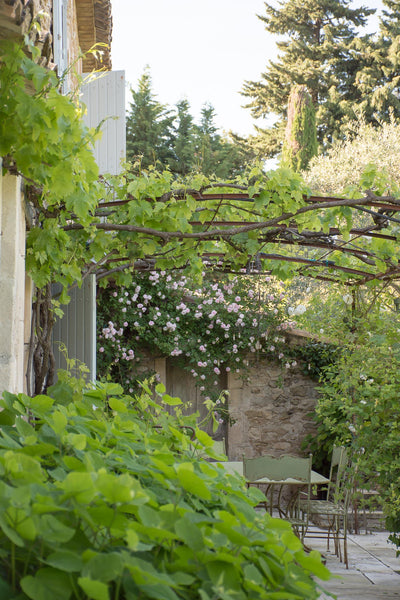
Garden lighting can be used to enhance architectural elements and large trees for special occasions after dark. Using antique French lanterns can add French lumiere to your night garden. Goose neck wall sconces with enamel shades are a classic choice for illuminating dining areas and pathways for circulating around the graden.
6. Play with geometry
The monumental gardens of the chateaux of the Loire, the Tuileries and even the grand avenues of French cities are all designed around geometry and pattern. But you don’t need a huge area to achieve a geometrical design in your green space. Consider framing pathways or smaller areas with neatly clipped hedges or plant hedges in rows trimmed to different heights and shapes. This is a good way to plant out from under a large shady tree where it can be difficult for other plants to grow. If you are working with a smaller space, the topiary-style of growing plants in pots can create a geometrical effect and a living sculpture.
7. Welcome guests outdoors
The French enjoy spending time in their gardens – it is part of la vie quotidien.
Relaxing by the swimming pool or reading under a tree are moments to savor and enjoy in solitude or with company. An afternoon siesta on a comfortable sun lounge is the ultimate summer ritual! Creating shade is essential for the hot months - umbrellas and trees will provide shade cover and if there is a fountain nearby, this will have a cooling effect too.
In Provence, most meals are enjoyed together alfresco during the summer months. Patterned tablecloths from the weekly marché add color to an outdoor tablescape, and fresh-cut floral and herb bouquets from the surrounding garden make a lovely centerpiece.
Plant fragrant wisteria and jasmine where it can climb and bloom abundantly - you will notice that the perfume is more pronounced as the heat of the day passes.
Harvesting flowers and home-grown fruit and vegetables is a true pleasure. They also make a special gift for friends.
8. Plant French classics
Heirloom roses are found in all French gardens. Some classics are Pierre de Ronsard, Cecile Brunner, Buff Beauty, Jacques Cartier, Souvenir de Mme Auguste Charles and New Dawn. Planting en masse means enjoying spectacular blooms from spring through summer. Offer bouquets to friends or pop them in vases in the living room, powder rooms an on night stands.
Plant trees en masse
Repetitive planting gives rhythm and structure to a garden. Avenues of plane trees, olive trees, and cypress are typical of French gardens, particularly in Provence. Wild birds will enjoy using their sheltered branches for building nests.
Consider creating a visual axis that can frame a specific view or natural landmark. A combination of evergreen and deciduous trees will add interest and color throughout the seasons well into the fall.
Deciduous trees are pruned back dramatically in the winter in French gardens - usually biannually. The healthy, knobby exposed branches make them look very sculptural after their leaves have dropped. Pear and apple trees are espaliered to save space and make the harvest more efficient. Pruning and training trees in this artful way is very rewarding and very French!
Fill your planters with shrubs and climbers
French garden planters can be enjoyed from indoors if placed on windowsills. Large collections of terracotta pots grouped together and planted with boxwood topiaries makes a great visual impact in a courtyard or terraced area.
Typical French climbers include: grape vines (Muscat is a delicious variety); colorful bougainvillea with orange-red, pink-purple or burgundy-colored flowers (in Mediterranean gardens); scented star Jasmine, and ivy.
The climbers can be trained on wire and trellises to cover walls and provide vertical greenery where space is limited. French shrubs include lavender, roses bushes, hydrangeas, rosemary, and seaside daisies for a French cottage touch.
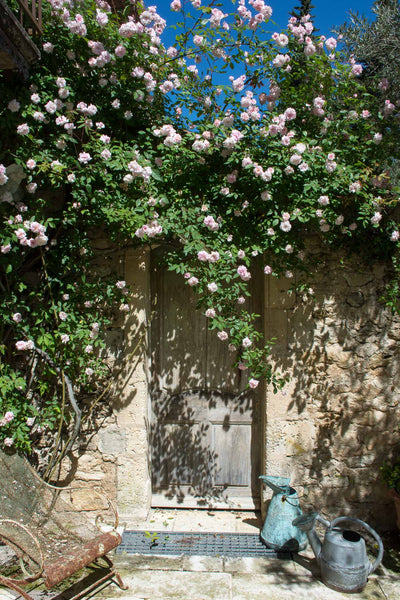
Boxwood does well in shady gardens and the planning and maintenance are well worth the effort for a stunning lush display. Symmetry and axes are classic design features in traditional French gardens. Even if your outdoor space is petit, a few potted boxwood plants carefully arranged will suggest a sense of order and help frame the space. This can also work well on a terrace or balcony.
Determining circulation paths and access points is the most logical way to start planning your garden layout, then it becomes easier to decide what to plant where.
Views can be framed with intentional plantings that will accentuate the prospect and direct the eye.
Bonus. Understand your climate zone
France has a temperate climate but various distinctive zones, including oceanic (west), semi-continental (north and north-east), Mediterranean (lower Rhône valley) and mountain (Alps and Pyrénées). Accompanied by photographs, the following is a short introduction to these different climates and the typical gardens found there including: Normandy (Oceanic), the Loire Valley and Paris (north and north-east), and Provence and the French Riviera (Mediterranean).
Coastal gardens of Normandy
The western and north-western windswept and often rainy region of France has a variety of landscapes including marshlands, dunes, steep cliffs, pine forests, and has given much inspiration to French artists. Rouen is the city of Emma Bovary's bleak home and the famous cathedral that Monet painted in series; while the coastal town of Cabourg is said to be Proust's setting for fictional Balbec; and Cherbourg, although a place of much pluie where an umbrella is necessary year-round is delightful nonetheless in Jacques Demy's The Umbrellas of Cherbourg.
Plants that withstand frosts, harsh winds, and salty air will thrive in the oceanic climate and include rhododendrons, agapanthus, clematis, grasses, sea-hardy flowers, shrubs, lovely old trees, and hundreds of varieties of roses.
Such a romantic mix of trees and flowers in the above photo - note the Medici urns and outdoor chair. Apparently wildflowers and sea-hardy flowers bloom all year (even in winter), but cover gracefully and completely the natural landscape in spring. In winter it is possible to grow daisies, dandelion, shepherd's purse, fumitory and white dead nettle. While in early spring gorse, wild garlic, snowdrops, and early purple orchid primroses appear, followed soon after by wood anemones, bluebells, cowslips, pyramid orchids, oxlips, and campion to list only a few. Plants that are native to the area naturally will thrive and look most harmonious in the landscape. These plants also will provide sought-after nourishment to bees, butterflies, and other local insects.
To shelter from the forceful sea air, the homes of Normandy often feature thatched roofs, exposed timber frames on their façades, and they are wonderfully cozy with inviting open fireplaces.
As the walls are thick, there is plenty of space to accommodate a planter in the window bringing the outdoors in. There are lovely shrub (or herbaceous) borders in the background in the photograph above. Succulents also thrive in the north.
The gardens along this rugged coastline receive plenty of rainfall - lush lawns and huge hydrangeas can thrive in the French gardens of Normandy.
The lush gardens of the châteaux in the Loire Valley
For most of the year, the weather of the Loire valley is moderate and comfortable. The areas to the west are influenced partly by weather from the Atlantic Ocean (more rain and milder temperatures) while the more easterly regions experience a continental climate (hotter and drier summers and colder winters).
The Loire valley is well known for its abundance of châteaux (there are over 1000) and the ordered gardens that grow within. Symmetrical parterres (ornamental flower beds), avenues of lofty deciduous trees, and meticulously espaliered fruit trees are major characteristics of these grand residential gardens in central France.
The large landscapes depicted are organized symmetrically and along geometrical lines and consider depth of space and play with perspective. Plants are often grouped by color and arranged to give a layered look: sky meets tree, tree brushes against clipped hedge, hedge groups flowers, which meet hardscaping, such as pathways of river stone or pebbles. No matter the region, traditional French estate gardens follow principals of design that with a resourceful, inventive mind can be applied to smaller-scale projects.
One will encounter stone statuary while strolling through traditional gardens in France. In these photographs beautiful stone pots are set amongst various clipped trees and topiary that frame ornamental garden beds blossoming with hydrangeas or potagers (kitchen beds).
Parisian style courtyards
The French capital experiences four distinct seasons, often cloudy weather year-round, regular light rainfall sometimes on a daily basis, very cold winters, and fairly mild but short summers.
The historic city of Paris is famed for stunningly beautiful and well-kept gardens like the Tuileries, Luxembourg Gardens, and the Bois de Boulogne. Among these beautiful public green spaces, lie the petite and chic private Parisian courtyards. These intimate spaces welcome herbaceous topiaries in antique planters, decorative plant stands, wrought-iron tables, and charming chairs with lovely outdoor pillows all snugly set between ancient stone walls.
Small outdoor settings invite a morning coffee or an evening aperitif with friends.
Our collection of outdoor Antique French furniture includes small settings well-suited to courtyards.
Rooftop terraces – pied-à-terre
A rooftop terrace is a luxury to make green with topiary bushes, trees, planted urns, pot plants, and creeper clad walls. A lush rooftop is a welcome retreat from bustling city life or village streets. Take a look at the photograph below - ooh la la!!
Geraniums and lemon-scented pelargoniums will bloom all year round on a sunny terrace. A backdrop of potted citrus or fruit trees and shrubs simply furnished with a bistro table, folding chairs, and an umbrella will help create a secluded getaway with an unmistakable French feel. Wrap up in a cozy blanket and experience all of the seasons on the terrace of your own magic mountain.
Sun-drenched Provençale country gardens
The Mediterranean climate in south-eastern France is characterized by hot dry summers, lots of sun year-round, usually mild weather with rain in fall and early spring, and cool to cold winters.
Plane trees, olive trees, cypress pines, lavender, rose bushes, and climbing plants like wisteria, trumpet vines, and jasmine are found in most Mediterranean gardens. Large planted urns, topiary, clipped hedges, arbors, beautiful garden benches, and stone statuary also are to be found.
The sectioned areas of a Provençale garden provide singular interest (such as a potager, parterre, water feature, or outdoor dining furniture). Large country gardens in Provence often will have a vast lawn that meets a vineyard, lavender field, prairie, or olive grove. The fringes where the property meets the countryside can be some of the most poetical parts of the garden.
Exotic cliff-side Mediterranean gardens of the French Riviera
Salty coastal Mediterranean gardens are planted with flowering cacti and slender palms as though they were sculptures. They frame the glistening Mediterranean waters and provide spots of shade in the summer months. As winters are mild in this climate temperature-sensitive plants such as citrus need not fear frosts.
The southern regions are famous for beautiful pots traditionally used to store olives and oil. Ancient Biot jars are the most authentic and are found frequently in the coastal gardens of the Côte d'Azur. These distinctive clay jars add an instant Mediterranean touch to any garden.
The beautiful round, smooth form of the Biot jar evokes the olive. These vessels often are found mounted in a prominent position so they can be admired habitually.
Little garden lamps can be placed nearby to illuminate the jars to enjoy after sunset.
For further ideas we have wonderful collections of both classic antique olive jars and artisan made Biot jars.
Choose the right climatic region for you
Remember to consider the size of your space and its sun exposure and aspect. Your plants will love and reward you by growing healthily and happily if you choose plants suitable to your local climate and soil and pots that can accommodate them. A helpful resource for finding your equivalent weather zone in France can be found here: United States hardiness hardiness zones, which range from one to thirteen (coolest to warmest).
Below are the comparable climate zones of regions in France:
Zone 8 - Paris, Loire Valley, Normandy and the Atlantic
Zone 9 - Provence, The French Riviera (Côte d'Azur)
Et voilà. Thank you for reading eight ways to create your French garden!
Image credit: Chez Pluie Provence, Eco-Gites, La Paternelle by Kirsten Honeyman, Chateau Mireille Saint Remy de Provence, Brooke & Steve Giannetti Patina Farm, Cote Maison, Southern Living, Le Domaine d’Ablon, Pinterest.
Explore our collection of French garden furniture and planters here.
Explore our exquisite collection of French garden décor and add French flair to your garden.
Our timeless biot jars are handmade-to-order in France
Our classic Anduze urns are handmade by artisans in Anduze
Frequently asked questions
1) What are the characteristics of a French garden?
Whether in a large estate, farmhouse, townhouse, or part of the courtyard, all French gardens share some common characteristics, including: some sense of order, whether that be in the form of parterres, bosquets, potagers, or topiary. A number of décor items are found in all types of gardens that give them a quintessentially French feel, including: Anduze urns, Biot jars, Medici urns, outdoor garden furniture, sculpture, and water features.
For more information, read our blog “8 ways to create your French garden” and visit Chateau de Villandry to see some more spectacular French gardens: https://www.chateauvillandry.fr/en/.
2) Which plants that grow in France will grow in the US?
Copying French garden design in the spirit rather than in the letter is the advice of American garden experts. It is best to adopt forward-thinking practices that support sustainability and choose plants that suit your local climate, are native to your local landscape, and are waterwise. Also they will be easier to grow! A helpful resource for finding your equivalent weather zone in France can be found here: United States hardiness hardiness zones, which range from one to thirteen (coolest to warmest).
Planned by Beatrix Farrand (1872–1959), the breathtaking gardens of Dumbarton Oaks draw on some traditional French garden landscape designs, including the Orangery, Swimming Pool and Loggia, the Green Garden Terrace, the Urn Terrace, and the Kitchen Garden. Together with Mildred Bliss (1879-1969), Farrand carefully chose and designed garden ornaments, such as benches, gates, finials, and sculptures. For inspiration peppered with tips for gardening in the US, visit https://www.doaks.org/visit/garden/explore.
Oak Spring Garden, Upperville, VA, designed by Rachel “Bunny” Mellon was influenced in part by the French style. The Oak Spring Garden Foundation is a wonderful resource for gardeners, enthusiasts, and plant lovers.
Paula Deitz is Editor of Hudson Review, a garden writer and cultural critic and I recommend her book, Of Gardens: Selected Essays (Penn UP, 2016), which can be purchased at bookshops. https://www.upenn.edu/pennpress/book/14785.html
3) Jardin à la française: How do I give my terrace or patio a French feel?
“Nothing is more tantalizing or inducive to fantasy than a beautifully trimmed garden with a refreshing fountain in an enclosure that no one may enter,” quips Paula Deitz in Of Gardens (2016). Designed by Russell Page, the beautiful terrace on East 70th Street, part of the Frick Collection, is similar to one he designed on the rue de Varenne in Paris, and Deitz adds, it “evokes the same sense of catching a glimpse of a private French garden.” Visit the Frick Collection website for inspiration on terrace design.
Create a cozy retreat on your balcony, and use ornamental vines as complements to architecture, around a doorway or window. Install a planted urn or lovely garden sculpture. Charming outdoor furniture, made from wicker or wrought iron will prolong lounging time en plein air.
4) Where can I buy French outdoor furniture?
Chez Pluie specializes in French antiques and vintage furniture and is exclusively online, please explore our range of French outdoor furniture via Chez Pluie.
If you visit France in person, be sure to visit the local brocantes and marches to hunt for some good finds. You can arrange shipping with Chez Pluie.
Related Posts:
Ten ways to create the Patina Farm aesthetic
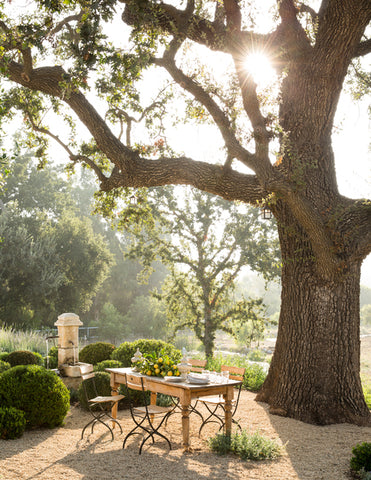
The most beautiful French Gardens - Dominique Lafourcade
The Biot Jar; An Ancient French Tradition
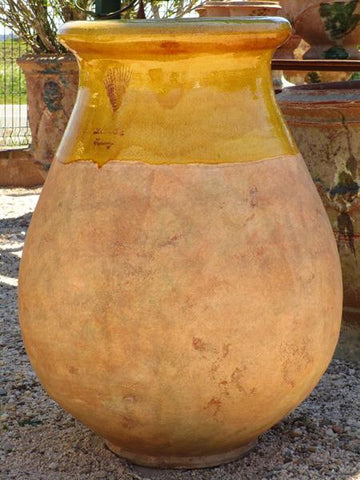
The Anduze Urn; Timeless Elegance

Six ways to create your modern farmhouse kitchen
Seven ways with demijohn bottles
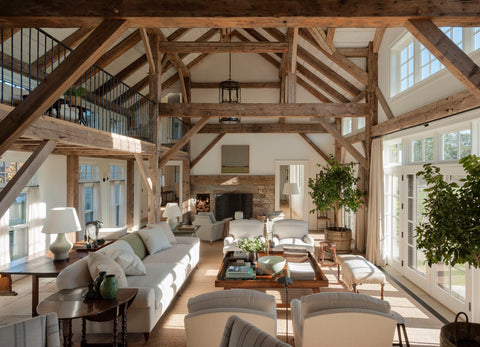
Pam Pierce: classic decor ideas
11 comments
Beautiful!
Lovely pics and detailed info.
FYI – I think we all know the woman and child statue is aka The Virgin Mary and infant Jesus.
Europe is generally of a Catholic and Protestant faith.
Thank you,
Tina
Wonderful website. A lot of useful info here. I am sending it to several friends ans additionally sharing in delicious. And certainly, thank you in your sweat!
Thank you for your very informative and beautiful article. I feel inspired to create my own french courtyard now! I appreciate the way you have broken down the specific elements of a french garden. Your article has been very helpful. Merci!
Thank you for sharing your beautiful pictures and your fountain of knowledge.
Everything was Absolutely Beautiful!
Since I am half French I can see why I am attracted to Everything. It was like putting on a Shaw. Merci
Delightful and inspiring reading, so romantic the French influence, whether
old or new, one of the few styles where very old and worn looks beautiful.
So lovely.
Awesome, best ideas for french look an garden
What is name of climbing rose? Thanks
Many thanks Kirsten for your kind comments and reference. Yours sincerely, Susannah Cameron
Wonderful images and commentary on French garden style! I notice you used my photograph of the charming garden at La Paternelle. Please provide a link in the photo or caption to this original content in case your readers would like to know more about the garden: http://www.ladolcevitacalifornia.com/2014/01/translations-creating-wonderful-whimsey.html Merci!





